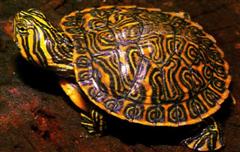Florida Cooter
Scientific Name: Pseudemys floridana floridana
Thu, 21st November, 2024 - 2:43 pm GMT
Sponsor Ads:

Alternative Name
Scientific Name: Pseudemys floridana floridanaBasic Info
Averaging between 9 and 13 inches, the Florida Cooter is a moderately sized turtle. They are very similar in appearance to the River Cooter. Florida Cooters have a dark carapace and light yellow plastron that lacks a pattern. Their shell is patterned with concentric rings and the head and neck is striped. Males can be differentiated from females by their elongated front claws.
Health
Breeding Florida Cooters breed between May and July. The females dig several nest cavities within inches of each other and lay one egg in each cavity. They usually lay at least two clutches, each consisting of between four and twenty-two eggs. The eggs incubate between 80 and 150 days before hatching. Male Cooters mature quicker then females, in about three years. Females usually mature after six or seven years.Habitat
Florida Cooters make their home in large ponds, canals, slow-moving rivers, and lakes where there is plenty of vegatation and lots of places to bask in the sun.Behavior
The Florida Cooter is of the family emidydae, the largest family of turtles. They enjoy spending most of their time basking in the Florida sun. They often pile on top of one another to receive the optimal amount of sun. These turtles love to bask! They are not shy about basking with other species of turtle as well. Florida Cooters are very timid animals and if approached, will usually retreat into the water. In the wild the Florida Cooter typically eats aquatic vegetation.Origin
Southeast United StatesHistory
Florida Cooters are, as the name would suggest, found mainly in Florida with a range that extends into southern North Carolina. The word "cooter" is derived from the African word 'kuta', meaning 'turtle' in many dialects.Common Foods
N/ASponsor Ads:
Never argue with a fool...people may not be able to tell you apart. -- Unknown
Florida Cooter
Coded by: BGID® | ALL RIGHTS RESERVED Copyright © 2000-2024
Disclaimer | Privacy | Report Errors / Contact | Credits









 Beware the new Naval power, they are planning to come on stream with big naval might to match their ground forces. Chinese Aircraft Carrier - Chinese Navy
Beware the new Naval power, they are planning to come on stream with big naval might to match their ground forces. Chinese Aircraft Carrier - Chinese Navy  versus
versus 
 versus
versus  This Thread is about the North Korean Military itself - the kind of army, navy, and air force they have.
This Thread is about the North Korean Military itself - the kind of army, navy, and air force they have. 
 versus
versus  versus
versus 
 versus
versus  versus
versus